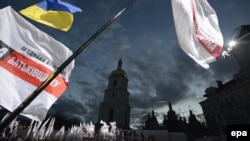Since gaining independence from the Soviet Union in 1991, Ukraine has held five presidential (1991, 1994, 1999, 2004, and 2010) and five parliamentary (1994, 1998, 2002, 2006, and 2007) elections.
Here is some of the most basic information about the 2012 elections to pick a new parliament on October 28:
Ukrainian Electoral System
Since independence in 1991, the electoral system for parliamentary representation in Ukraine has changed a number of times:
In 2011, government leaders declared their intention to change the electoral law ahead of the parliamentary elections slated for October 2012. The relevant bill was drafted by a parliamentary working group with limited participation by civil society and independent organizations. Among other provisions, it reintroduced a mixed proportional/majoritarian voting system, raised the threshold for party representation from 3 to 5 percent of the vote, and barred parties from running together in electoral coalitions or blocs.
In October 2011, the OSCE issued a joint opinion on the Draft Law on Election of People's Deputies of Ukraine, together with the Venice Commission of the Council of Europe, saying that the draft law represented a return to the mixed electoral system in use in Ukraine in 1998 and 2002 and that such frequent changes of the electoral system did not contribute to the stability of the electoral legal framework and electoral system. Following civil-society protests, a working group including both pro-government and opposition lawmakers developed a compromise draft that still largely reflected the government's political goals. The bill was adopted on November 17, 2011.
Under the current election law, out of the 450 parliamentary seats up for grabs, 225 will be distributed through a proportional system among the parties that win at least 5 percent of the vote, up from the previous 3-percent threshold. The other half will be allotted accordingto first-past-the-post races in 225 single-mandate constituencies. The candidates can represent parties or run independently.
Here is some of the most basic information about the 2012 elections to pick a new parliament on October 28:
- There were 36,687,114 names in the State Voter Register as of August 31.
- The elections will use a mixed voting system: 50 percent under party lists and 50 percent under simple-majority constituencies with a 5 percent election threshold.
- In electoral districts, there were 87 parties registered for these elections.
- Ukraine's Central Election Commission registered 22 parties for the nationwide list.
- Political party blocs are no longer allowed.
- The election campaign was limited to 90 days.
- The option "vote against all" was not included on ballots.
- Voting was broken up into 225 single-member districts, conducted at 33,769 polling stations, and included 116 foreign polling stations in 77 countries.
- The new parliament is scheduled to start its session in mid-December.
Ukrainian Electoral System
Since independence in 1991, the electoral system for parliamentary representation in Ukraine has changed a number of times:
- Before 1998, all members of parliament were elected in single-seat constituencies;
- In 1998, a mixed system was introduced, with half of the 450 deputies elected by proportional representation and the other half in single-seat constituencies.
- In 2004, a party-list, proportional-representation system using closed lists was introduced. It was applied in the 2006 regular and 2007 early parliamentary elections.
In 2011, government leaders declared their intention to change the electoral law ahead of the parliamentary elections slated for October 2012. The relevant bill was drafted by a parliamentary working group with limited participation by civil society and independent organizations. Among other provisions, it reintroduced a mixed proportional/majoritarian voting system, raised the threshold for party representation from 3 to 5 percent of the vote, and barred parties from running together in electoral coalitions or blocs.
In October 2011, the OSCE issued a joint opinion on the Draft Law on Election of People's Deputies of Ukraine, together with the Venice Commission of the Council of Europe, saying that the draft law represented a return to the mixed electoral system in use in Ukraine in 1998 and 2002 and that such frequent changes of the electoral system did not contribute to the stability of the electoral legal framework and electoral system. Following civil-society protests, a working group including both pro-government and opposition lawmakers developed a compromise draft that still largely reflected the government's political goals. The bill was adopted on November 17, 2011.
Under the current election law, out of the 450 parliamentary seats up for grabs, 225 will be distributed through a proportional system among the parties that win at least 5 percent of the vote, up from the previous 3-percent threshold. The other half will be allotted accordingto first-past-the-post races in 225 single-mandate constituencies. The candidates can represent parties or run independently.




